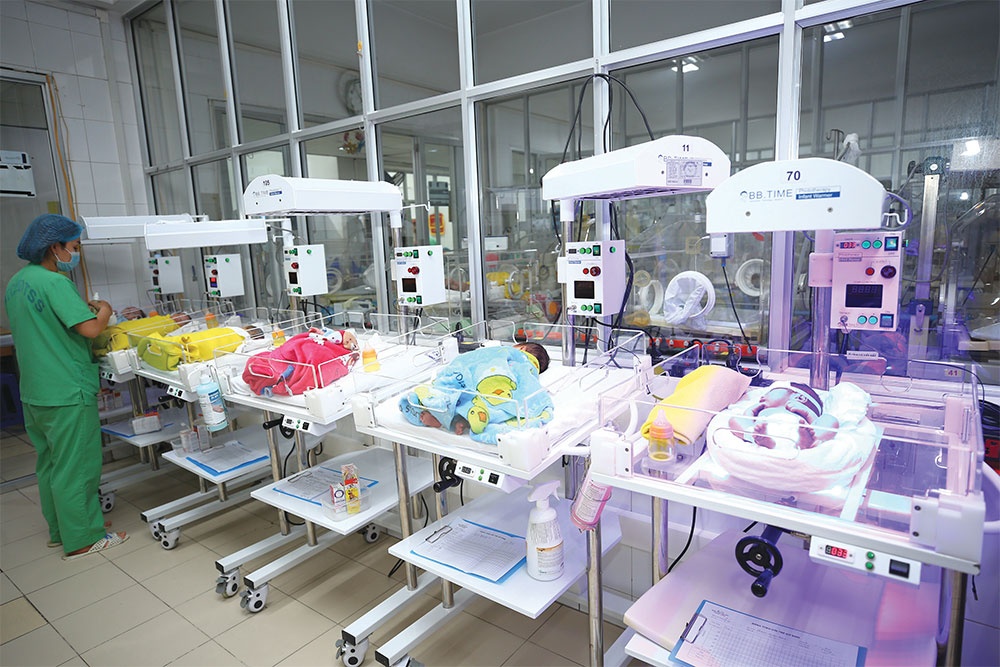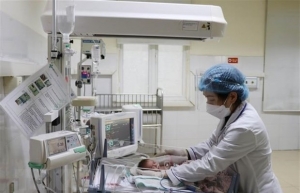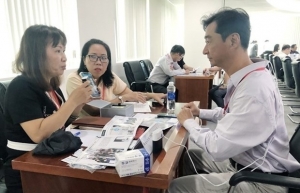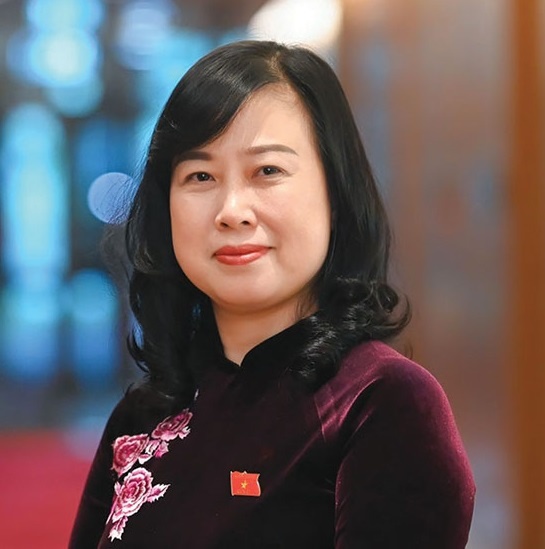Hospitals proactive in supply status
Trinh Ngoc Hai, deputy director of Vietnam National Children’s Hospital, is witnessing an increase in the number of patients with about 5,000-6,000 a day, including 2,000 inpatients. There are also regularly nearly 100 children on ventilators and 100 children on oxygen.
 |
| Hospitals proactive in supply status, illustration photo/ Photo Le Toan |
“The examination and treatment of such a number of paediatric patients needed a large number of drugs and medical supplies,” Hai said. “Post-pandemic, interruptions in the supply of many drugs and medical items from manufacturers have significantly affected the bidding and procurement at medical facilities, including the hospital.”
To ensure supply, the hospital has been taking a number of solutions. It established a specialised scientific council with the participation of many experts from faculties, departments and centres.
The Drug Procurement Council, the Medical Equipment Procurement Council, and a procurement council for testing supplies and biological products were established to evaluate the list of drugs alongside their active ingredients and technical features. Now, the hospital has deployed bidding and procurement based on the opinions of the councils.
“The hospital is also flexible in conducting bidding and purchasing. It divides into many different bidding packages. We have organised many rounds of contractor selection and successfully conducted bidding and procurement according to current regulations for more than 50 bidding packages of equipment, supplies, and drugs, broadly meeting the needs of medical treatment,” Hai explained.
“In bidding and procurement, we are very persistent. For example, in a typical bidding, we expect to bid and purchase about 1,000 items of medicine and medical supplies, but for many other reasons, such as contractors not participating, there is not always enough supply, quality, or the right price. So, only around 70 per cent of needs can be fulfilled,” Hai added.
At a Q&A session nearly three weeks ago at the National Assembly, Prime Minister Pham Minh Chinh said that the shortfall of pharmaceuticals and medical equipment and supplies is being solved step by step.
He emphasised that the government will focus on directing a number of tasks, such as submitting amendments to medical laws to resolve issues related to drugs, equipment, medical supplies, and medical insurance. Thus, the development of the pharmaceutical and medical equipment industries will be promoted to ease overload, increase service quality, and promote manpower training.
| Dao Hong Lan, Minister of Health
The National Assembly, the government, the prime minister, and ministries have supported problem solving related to various policies. The health sector is one of the most prioritised sectors related to such policies to ensure medicine, equipment, and medical supplies. For example, when other units carry out procurement, they still have to ensure three quotations, but the health sector specifically has regulations that require only one quotation in case of necessity to ensure the procurement. Low price issues have been resolved. In times of necessity, if medical supplies are not at the lowest price, the healthcare industry can still buy them if guaranteed and clarified by the Scientific Council. The current Law on Public Procurement also provides many specific procurement contents for the healthcare sector. With such recent resolutions helping to solve problems related to supply of drugs and medical equipment, the barriers related to procurement mechanism have been removed, but we are still facing a shortfall. Currently, there are three units responsible for buying medicine. The Ministry of Health (MoH) is only in charge of centralised bidding at the national level, only accounting for about 16-18 per cent of the total, while the rest comes from centralised bidding at the provincial level and facilities directly making purchase for themselves. Over the past few months, the MoH has continuously issued documents asking all units and agencies to gather the remaining problems so that the ministry could continue to submit them to the competent authorities to solve. In general, the lack of drugs, medical equipment, and supplies is blamed on subjective and objective reasons. Firstly, in the actual implementation of bidding in localities, doctors are specialists and do not have in-depth expertise in bidding, so the process is still confusing. The second aspect is related to decentralisation. For example, the ministry has fully decentralised facilities under the ministry to be responsible for procurement. However, in some localities, medical facilities only guarantee purchases of less than VND100 million ($4,200). If the purchase if over that amount, it must be submitted to the provincial department of health, department of finance, and provincial people’s committee for approval, so procurement takes a long time. The ministry hopes that in the coming time, cities and provinces will review this regulation to ensure both management and empowerment of units. In the amended Law on Medical Examination and Treatment, there are regulations on borrowing and advances for medical equipment and supplies. Units are also guiding implementation of the law to ensure long-term effectiveness. Moreover, in the regulations on procurement and bidding, there is no form of borrowing, borrowing in advance, paying later, or borrowing and then bidding to pay back. During the battle against the pandemic, we borrowed test kits, but when the pandemic was over, we cannot pay in kind. However, to meet the need for COVID-19 prevention and control, the issue of ensuring people’s lives and health came first. That was why in that time, in practice, many medical facilities had to make advances or borrow medical equipment and supplies to ensure treatment needs as well as testing. The government has been assigned to resolve problems related to borrowing medical equipment and supplies at medical facilities before the end of 2024. This is a difficult task. The MoH has coordinated with people’s committees up and down the country to implement this task. It has sent two official dispatches to them, asking to report on the current situation of local borrowing as well as that of medical facilities. To date, the MoH has compiled statistics on 48 localities and seven ministries and agencies, as well as medical facilities under the ministry. Currently, the amount of such borrowing according to official reports is VND1.69 trillion ($71.3 million), of which borrowing medicines and biological products is about VND754 billion ($31.8 million), and about VND939 billion ($39.6 million) for test kits. On this basis, we classify the types of borrowing, whether they have a bidding contract or a negotiated price or do not have anything at all, from which to develop a thorough settlement plan. The MoH is now also assigning its units to develop plans and reports to have a mechanism to handle and remove difficulties for medical facilities as well as solve them for the long term. ( * Excerpt from speech at ongoing sixth session of the National Assembly.) |
Many other hospitals in the country face the same issues as the Vietnam National Children’s Hospital.
According to Dr. Duong Duc Hung, director of Vietnam-Germany Friendship Hospital in Hanoi, the number of patients going for examination and surgery at the hospital since the peak of the pandemic has increased by about 200 per cent. Meanwhile, the regulations on procurement can only meet an extra 130 per cent.
“The supply of many drugs and equipment are interrupted. Many surgical instruments or surgical specialities have only one or two suppliers. This creates much pressure and affected the hospital’s plans,” Hung said.
To deal with this, this hospital has shortened many regulations in the bidding and procurement process. Also, the hospital’s Board of Directors has assigned specific professional groups, such as a pharmaceutical group, a certain amount of time to carry out bidding and procurement.
“We apply a special mechanism. For example, with paracetamol on the market, there are many different types. When bidding, if there is no product, the hospital can buy replacements with the same active ingredients,” Hung added.
However, by applying the usual form of procurement for medical supplies and chemicals with specific characteristics, there are always shortcomings.
“For example, there are machines and materials that are supplied by only one company in the world; and in Vietnam, there is also only one distributor,” Hung said. “Therefore, it is necessary for medical procurement to have special rules, not like shopping for common goods.”
At Bach Mai Hospital in Hanoi, three key factors are in focus to ensure enough pharmaceuticals, medical equipment, and supplies. Assoc. Prof. Dao Xuan Co, the director of the hospital, said, “We ensure transparency in bidding and procurement; create improvements for qualified bidders; and train staff about bidding and procurement. As a result, a series of hospital bidding packages have had prices reduced by 15-30 per cent lower than our plans.”
He added that the government and the Ministry of Health (MoH) have made urgent instructions to solve bidding-related problems. “Specifically, a government decree has made customs clearance of medical equipment, supplies, and chemicals more convenient, while an MoH circular has also resolved many issues nationwide,” Co said.
Bach Mai Hospital has so far won many bidding packages and purchased drugs, medical equipment, and supplies worth nearly $169 million.
Pham Nhu Hiep, director of Hue Central Hospital in the central province of Thua Thien-Hue’s Hue city, said that each day the hospital accommodates up to 5,000 inpatients, and performs 150-200 surgeries and many other activities. Therefore, the demand for medicines is huge.
“We have applied measures to ensure efficiency of bidding and procurement,” Hiep said. “For example, in bidding, when we have results, we immediately prepare for upcoming bidding and procurement plans. In addition, we also have forecasts about the patient situation, equipment, and techniques. So even after the pandemic, when the number of patients increased dramatically, we have still been able to meet our needs.”
Hiep admitted that the hospital sometimes lacked various items during the bidding process. Realising this, it then picked up those items via re-bidding, direct purchases, or competitive offers to promptly ensure drugs and chemicals.
“In case of shortages due to disruption or supplier unavailability, we will use drugs and materials with similar effects to replace those missing,” Hiep said. “With the Law on Medical Examination and Treatment, the Law on Public Procurement, and many related regulations effective, Hue Central Hospital has been able to organise groups such as an expert appraisal team to serve our procurement and bidding plans for 2024.”
 | Medical equipment fortunes increase via rule untangling Foreign pharmaceutical firms will enjoy a fresh start in their medical equipment business as various shortcomings related to marketing authorisation were ironed out. |
 | Vietnamese, Taiwanese firms seek partnership in medical technology, equipment The “2023 Wow! Taiwan Project - Health Tech Business Matchmaking Event” was held in Ho Chi Minh City on September 12, drawing more than 60 businesses from Vietnam and Taiwan (China) and witnessing the signing of a variety of cooperation deals. |
What the stars mean:
★ Poor ★ ★ Promising ★★★ Good ★★★★ Very good ★★★★★ Exceptional
Themes: Healthcare Platform
- DKSH to acquire Vietnamese healthcare distributor Biomedic
- Two national hospitals expand capacity with new facilities
- Vietnam moves to enhance disease prevention, equity, and sustainability
- Vietnam unites to tackle major causes of disease and death
- Health Innovation Hub: accelerating health equity through digital healthcare innovation
Related Contents
Latest News
More News
- Human-centred governance seen as key to AI development (December 19, 2025 | 18:19)
- Top 10 notable events of Vietnam’s industry and trade sector in 2025 (December 19, 2025 | 14:00)
- Tungsten surges to 12-year high as world enters a new 'black gold' race (December 18, 2025 | 17:27)
- Vietnam’s coffee exports set new record despite price pressures (December 18, 2025 | 17:13)
- Garment and textile sector seeks new growth after volatile year (December 18, 2025 | 17:01)
- VinSpeed and Siemens strengthen cooperation for high-speed rail development (December 18, 2025 | 16:53)
- High-tech adoption for TH true MILK (December 18, 2025 | 13:39)
- Takeda supports health resilience amid climate change challenges (December 18, 2025 | 12:39)
- Mondelez Kinh Do - a chapter of purpose-led leadership in Vietnam (December 18, 2025 | 09:44)
- VNPAY services receive the highest-level PCI DSS international security certificates for six consecutive years (December 17, 2025 | 23:47)


 Tag:
Tag:





















 Mobile Version
Mobile Version